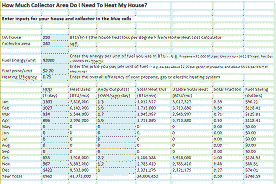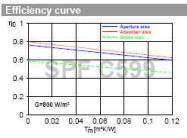| Solar
Collector Design |
| CoDePro -- Flat Plate Collector
Design Program
http://sel.me.wisc.edu/codepro/new_codepro.html |
Program develops the efficiency curve given
inputs on the collector glazing, absorber, insulation etc. |
| Active Solar Collectors and Their
Application Ari Rabl |
A great engineering reference on solar
collectors of almost all types. |
Effects of Tilt and Azimuth On
Annual Incident Solar Radiation For the United States Locations
Craig Christensen and Greg Barker
www.solar.fiu.edu/PDFs/pdfs/34892-31.pdf
|
 This
paper provides a very simple set of contour plots that show optimum
collector orientation, and the performance effect for deviations from
optimal. This
paper provides a very simple set of contour plots that show optimum
collector orientation, and the performance effect for deviations from
optimal.
Covers only the US, but the general relationships would be useful elsewhere.
Some limitations -- read the cautions in the paper. |
| Solar
Collector Ratings and Performance |
| Solar Collector and Certification
Corporation
The SRCC
website homepage...
The SRCC Collector Ratings page...
Select a collector by criteria and getting ratings...
(this is an easy way to find a collector or type of collector
among the hundreds of tested collectors)
How to use the SRCC collector ratings ...
|
 The SRCC provides independent certification, rating, and performance data
for solar collectors and for solar water heating systems. The SRCC provides independent certification, rating, and performance data
for solar collectors and for solar water heating systems.
This is (as far as I know) the only reliable way to get apples to apples
numbers on collector performance.To get the detailed report on a
collector, use the "Collector
Ratings Summaries" to find the collector you want, and then click on its
link to get the detailed report. |
Comparison Of Various Collectors,
Alan |
 Alan
uses the SRCC ratings and collector price data to evaluate the
price/performance for several flat plate and evacuated tube collectors for
his latest solar water heating project. Alan
uses the SRCC ratings and collector price data to evaluate the
price/performance for several flat plate and evacuated tube collectors for
his latest solar water heating project.
It is a great example of how to use the SRCC data to make a good decision on
which collector is best for a particular application. |
Solar Thermal
Collector Power Output Simulation,
Andy Schroder
http://andyschroder.com/solarradiation.html
Example of using the simulation to
estimate energy, fuel, and CO2 savings for a collector array...
Using this tool to answer questions like "How much collector area do I
need to heat my home"... |

This is a very useful simulation tool for determining output from a solar collector for your location and weather. It uses the your
local weather in combination with the efficiency curve for the collector you
select to estimate day by day performance for a full year. It uses weather
over the period from 1991 to 2005, and gives median year, best year, and
worst year performance.
Output is provided both as a graph and as a downloadable csv file for
further analysis by spreadsheet.
While Andy represents and sells a
particular brand of collector, the method covers a wide range of flat
plate and evacuated tube collectors. |
| How Much
Collector Area Do I Need To Heat My House? Or, Estimating Solar Heating
Fraction
Details ... |
 This
is a question I get asked a lot. Its a tough question that depends on
many things, but here is a method that you can use to get a pretty good idea
what your solar faction is likely to be for
your collector array... This
is a question I get asked a lot. Its a tough question that depends on
many things, but here is a method that you can use to get a pretty good idea
what your solar faction is likely to be for
your collector array...Its fairly lengthy to use, but not difficult. |
| SPF -- Solar Collector Performance
Tests
http://www.spf.ch/spf.php?lang=de&intro=1
|
 The SPF
provides performance test data for a wide range of solar collectors.
Collector performance and performance of the collector in 3 kinds of systems
are provided. All in a very readable format. The SPF
provides performance test data for a wide range of solar collectors.
Collector performance and performance of the collector in 3 kinds of systems
are provided. All in a very readable format. |

 This
paper provides a very simple set of contour plots that show optimum
collector orientation, and the performance effect for deviations from
optimal.
This
paper provides a very simple set of contour plots that show optimum
collector orientation, and the performance effect for deviations from
optimal. The SRCC provides independent certification, rating, and performance data
for solar collectors and for solar water heating systems.
The SRCC provides independent certification, rating, and performance data
for solar collectors and for solar water heating systems.  Alan
uses the SRCC ratings and collector price data to evaluate the
price/performance for several flat plate and evacuated tube collectors for
his latest solar water heating project.
Alan
uses the SRCC ratings and collector price data to evaluate the
price/performance for several flat plate and evacuated tube collectors for
his latest solar water heating project.
 This
is a question I get asked a lot. Its a tough question that depends on
many things, but here is a method that you can use to get a pretty good idea
what
This
is a question I get asked a lot. Its a tough question that depends on
many things, but here is a method that you can use to get a pretty good idea
what  The SPF
provides performance test data for a wide range of solar collectors.
Collector performance and performance of the collector in 3 kinds of systems
are provided. All in a very readable format.
The SPF
provides performance test data for a wide range of solar collectors.
Collector performance and performance of the collector in 3 kinds of systems
are provided. All in a very readable format.